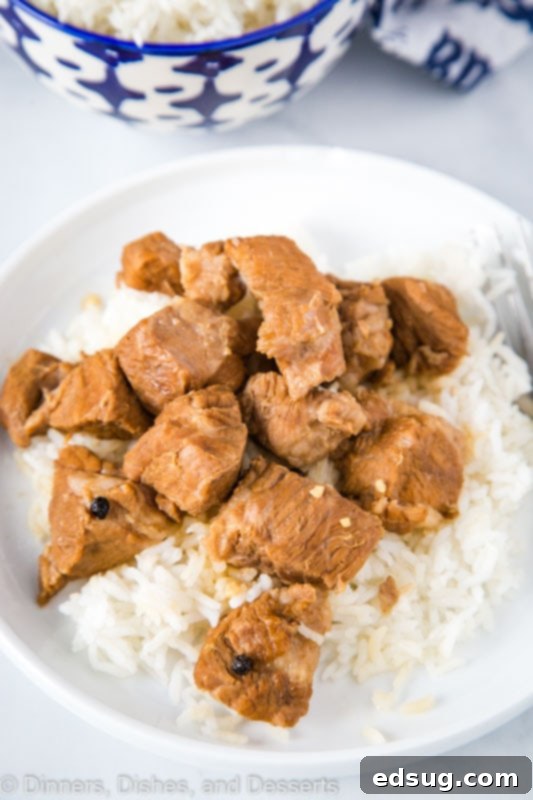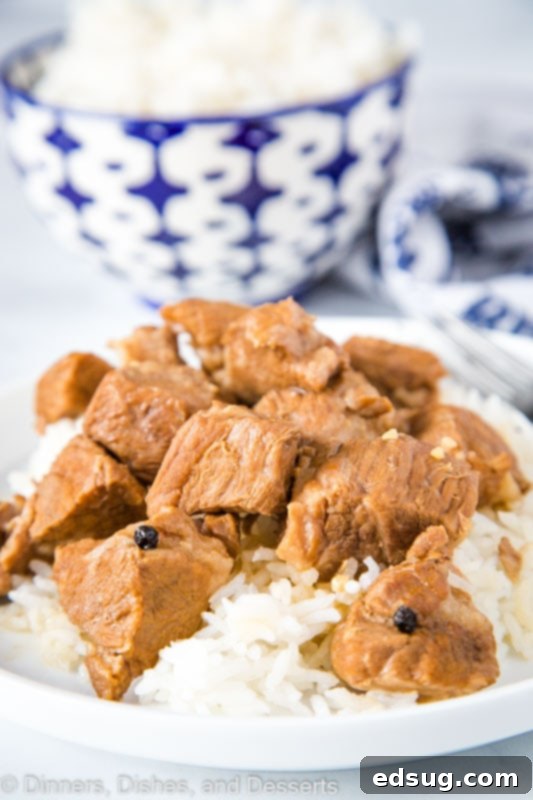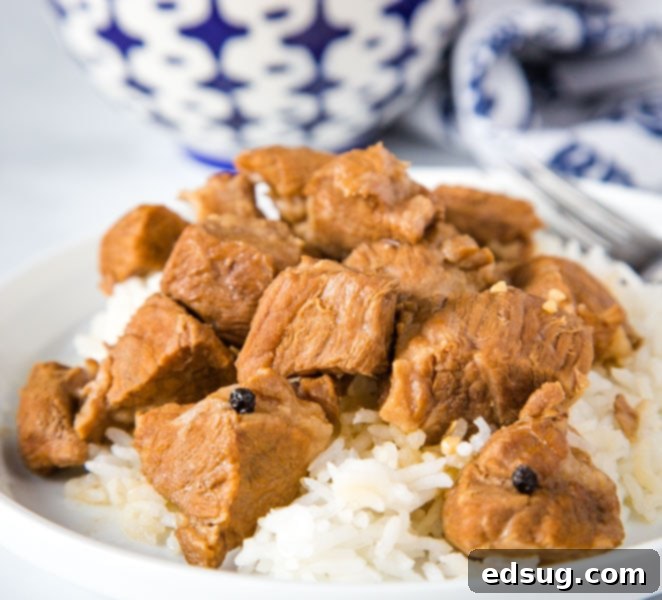Authentic Filipino Pork Adobo: A Rich, Tangy, and Tender Pork Recipe
Filipino Pork Adobo is a culinary gem, featuring succulent pieces of pork slowly cooked in a savory-tangy sauce made from soy sauce, vinegar, and aromatic garlic. This incredibly rich and flavorful dish is perfectly complemented by a bed of steamed white rice, promising a truly satisfying meal.
Exploring global cuisines from the comfort of our own kitchen is a true passion, and while we’ve dabbled in various Asian flavors, Filipino food remained an exciting frontier. Before discovering this incredible pork adobo recipe, my experience with Filipino dishes was limited, though always delicious when I encountered it with chicken. The distinct combination of savory, sour, and garlicky notes in adobo sauce is utterly captivating and always leaves me craving more.

The inspiration for finally diving into making pork adobo came during a recent cruise. One of the wonderful waitstaff, hailing from the Philippines, shared captivating stories about adobo and its unparalleled deliciousness. Her vivid descriptions were all the motivation I needed. As soon as we returned home, I was determined to recreate this iconic dish, and I can confidently say it exceeded all expectations. The result was a revelation, cementing adobo as a firm favorite in our household.
What is Filipino Adobo? The National Dish Explained
Filipino Adobo is not just a dish; it’s a cooking process and a cultural icon, widely considered the national dish of the Philippines. At its heart, adobo involves simmering meat, seafood, or vegetables in a distinctive mixture of soy sauce, vinegar, garlic, and black peppercorns. The word “adobo” itself is of Spanish origin, referring to a marinating or pickling sauce, which speaks to the colonial influences on Filipino cuisine. However, the method predates Spanish colonization, originally a way to preserve food through vinegar and salt. The addition of soy sauce came later, influenced by Chinese traders.
What makes adobo truly special is the incredible balance of flavors. The vinegar provides a delightful tang that cuts through the richness of the meat, while the soy sauce adds a deep umami and saltiness. Abundant garlic infuses the dish with its pungent aroma and flavor, and the peppercorns contribute a subtle heat and earthy undertone. This combination creates a deeply satisfying, complex sauce that coats every tender morsel of meat. While pork is incredibly popular for adobo due to its rich flavor and texture, chicken adobo is equally beloved, and regional variations might even feature squid or other seafood.
The magic of adobo lies in its slow cooking process. The meat (in this case, pork) is gently braised in the flavorful sauce for an extended period, allowing it to become incredibly tender and absorb all the wonderful spices. This long simmer also gives the fat in the pork time to render down, creating a silky, luxurious sauce that you’ll want to spoon over everything. It’s a dish that truly showcases how simple, core ingredients can be transformed into something extraordinary with time and care.
Essential Pork Adobo Ingredients: Simple Yet Powerful
One of the beauties of a classic pork adobo recipe is its reliance on readily available, straightforward ingredients. You don’t need exotic spices or hard-to-find components; just a few pantry staples come together to create an explosion of flavor. Don’t be intimidated by the rich outcome – the process is surprisingly simple!
- Pork Butt or Pork Shoulder: These cuts are ideal for adobo because they contain a good amount of fat and connective tissue. Slow cooking breaks these down, resulting in incredibly tender, juicy pork that practically melts in your mouth. Cut into 2-inch cubes for optimal browning and absorption of flavor.
- Soy Sauce: The cornerstone of adobo’s savory depth. Use a good quality regular soy sauce (not low-sodium unless you adjust for seasoning). It provides the essential umami and saltiness that defines the dish.
- White Vinegar: This is where the signature tang of adobo comes from. White vinegar offers a clean, sharp acidity that balances the richness of the pork and soy sauce. Filipino cane vinegar is traditional, but white vinegar is an excellent and accessible substitute.
- Vegetable Oil: Used for searing the pork, which is a crucial step for developing a rich, browned crust and locking in flavor before the simmering process begins.
- Garlic: Adobo is not shy with garlic! Minced garlic cloves are essential for building the aromatic base and providing a pungent, savory counterpoint to the vinegar. Don’t skimp on it.
- Bay Leaves: These fragrant leaves add a subtle, herbaceous note that deepens the complexity of the sauce. They release their aroma during the slow simmer.
- Black Peppercorns: Whole black peppercorns are traditionally used and release a nuanced, sustained warmth throughout the cooking process, rather than an intense spice. They are a signature element of authentic adobo.
- Water: Added to ensure there’s enough liquid for the pork to simmer and become tender, and later to allow the sauce to reduce and concentrate.
These simple ingredients, when combined and cooked with patience, transform into a dish that is far greater than the sum of its parts. It’s a testament to the power of traditional cooking methods and bold flavor profiles.

Mastering the Art of Pork Adobo: A Step-by-Step Guide
Making Filipino Pork Adobo is a rewarding culinary experience, and while it requires a little time, the steps are straightforward and lead to incredibly flavorful results. Here’s how to achieve that perfect balance of tender pork and rich, tangy sauce:
- Step 1: Sear the Pork for Maximum Flavor. Begin by heating a large, heavy-bottomed pot or Dutch oven over high heat with a couple of tablespoons of vegetable oil. Once the oil shimmers, add the pork butt or pork shoulder, cut into approximately 2-inch cubes. It’s crucial not to overcrowd the pot; sear the meat in batches if necessary. Browning the pork on all sides creates a beautiful crust and develops deep, complex flavors through the Maillard reaction, which is essential for a robust adobo. This step seals in the juices and builds the foundation of flavor for your sauce.
- Step 2: Simmer to Tenderness. After all the pork is beautifully seared and returned to the pot, it’s time to introduce the magic of the adobo sauce. Add the soy sauce, white vinegar, minced garlic, bay leaves, black peppercorns, and water. Bring the mixture to a boil, then immediately reduce the heat to a gentle simmer. Cover the pot with a lid and let it cook slowly for at least one hour, or even up to 1.5 hours. This low-and-slow cooking allows the tough connective tissues in the pork to break down, rendering the fat and transforming the meat into unbelievably tender, fall-apart perfection. It also gives the flavors ample time to meld and deepen, infusing every piece of pork with the distinctive adobo taste.
- Step 3: Reduce the Sauce for Richness. Once the pork has become tender after its initial covered simmer, remove the lid from the pot. Increase the heat slightly to maintain a steady simmer, and continue to cook uncovered for another 30-45 minutes. This crucial step allows the excess liquid to evaporate, concentrating the flavors of the sauce and giving it a thicker, richer consistency. You’ll notice the sauce transforming into a glossy, intensely flavorful glaze that clings perfectly to the pork. Stir occasionally to prevent sticking and ensure even reduction.
- Step 4: Serve and Enjoy! Adobo is traditionally, and best, served piping hot over freshly steamed white rice. The rice acts as a perfect canvas to absorb the savory, tangy sauce, creating a harmonious and comforting meal. Garnish with fresh scallions or a sprinkle of chili flakes if you like a touch of heat.
This patient process ensures every bite of your pork adobo is bursting with flavor and texture. It’s truly worth the wait!

Why This Pork Adobo Recipe is a Must-Try
If you’re looking to broaden your culinary horizons beyond your usual Asian takeout favorites like Chicken Lo Mein, this Pork Adobo recipe is an absolute game-changer. It’s a dish that introduces you to a vibrant, comforting cuisine with a relatively simple ingredient list.
While it does require patience to allow the flavors to develop and the meat to tenderize, every minute spent is truly worth it. The slow cooking process ensures the pork is incredibly tender and fully saturated with the rich, tangy, and garlicky sauce. Plus, one of the greatest advantages of adobo is that the leftovers are often even better the next day, as the flavors have more time to deepen and meld. It makes for fantastic meal prep!
This Pork Adobo recipe proves that you don’t need a pantry full of obscure ingredients to create an authentic, world-class meal. It harnesses the power of basic staples – pork, soy sauce, vinegar, and garlic – and combines them in a way that’s both innovative and deeply satisfying. You can literally travel the world through your dinner plate without ever needing to visit a specialty grocery store. These are precisely the kind of meals that become treasured family favorites!

Tips for the Best Pork Adobo
- Don’t Rush the Sear: Take your time browning the pork in batches. A good sear adds immense flavor and texture that you can’t get otherwise.
- Low and Slow is Key: The long simmering time is crucial for tenderizing the pork and allowing the flavors to penetrate the meat. Resist the urge to crank up the heat.
- Taste and Adjust: Towards the end of cooking, taste the sauce. Depending on your soy sauce and vinegar, you might want to add a pinch of sugar to balance the acidity, or a splash more water if it’s too salty or reducing too quickly.
- Consider Hard-Boiled Eggs: Many Filipino households add hard-boiled eggs to their adobo during the last 30 minutes of simmering. The eggs absorb the delicious sauce and make for a heartier meal.
- Serve with Sides: While white rice is a must, you can also serve adobo with simple blanched greens like bok choy or green beans to add a fresh, crunchy element.
Storage and Reheating
Pork adobo is one of those dishes that tastes even better the next day! Allow any leftovers to cool completely before transferring them to an airtight container. It will keep beautifully in the refrigerator for up to 3-4 days. To reheat, simply warm it gently on the stovetop over medium-low heat, adding a splash of water if the sauce has thickened too much. You can also microwave individual portions until heated through.
More Delicious Dinner Recipes to Explore
If you enjoyed this flavorful pork dish, you might also love these other comforting and delicious dinner recipes:
- Slow Cooker Pork Roast
- Lemon Garlic Pork Chops
- Instant Pot Pulled Pork
- Smothered Pork Chops
- Crispy Pork Cutlet
- Oven Baked Pork Chops

Pork Adobo Recipe
Pin Recipe
Rate Recipe
Print Recipe
Equipment
-
Pot and Pan Set
Ingredients
- 2 pounds pork butt or pork shoulder, cut into 2 inch cubes
- 2 Tablespoons vegetable oil
- 1/2 cup soy sauce
- 1/2 cup white vinegar
- 3 cloves garlic, minced
- 2 bay leaves
- 1 teaspoon black peppercorns
- 1/2 cup water
Instructions
-
In a large pot heat oil over high heat. Add the meat in batches and brown on all sides.
-
Once all the meat is browned add everything (including all the meat) to the pot. Bring to a boil. Cover and reduce heat to simmer for 1 hour.
-
After 1 hour, remove the lid and continue to simmer for 30 minutes until the liquid is reduced by half.
-
Serve over cooked white rice.
Nutrition
Nutrition information is automatically calculated, so should only be used as an approximation.
Additional Info
Like this recipe? Leave a comment below!
I created a fun group on Facebook, and I would love for you to join us! It’s a place where you can share YOUR favorite recipes, ask questions, and see what’s new at Dinners, Dishes and Desserts (so that you never miss a new recipe)!
Be sure to follow me on Instagram and tag #dinnersdishes so I can see all the wonderful DINNERS, DISHES, AND DESSERTS recipes YOU make!
Be sure to follow me on my social media, so you never miss a post!
Facebook | Twitter | Pinterest | Instagram
.
